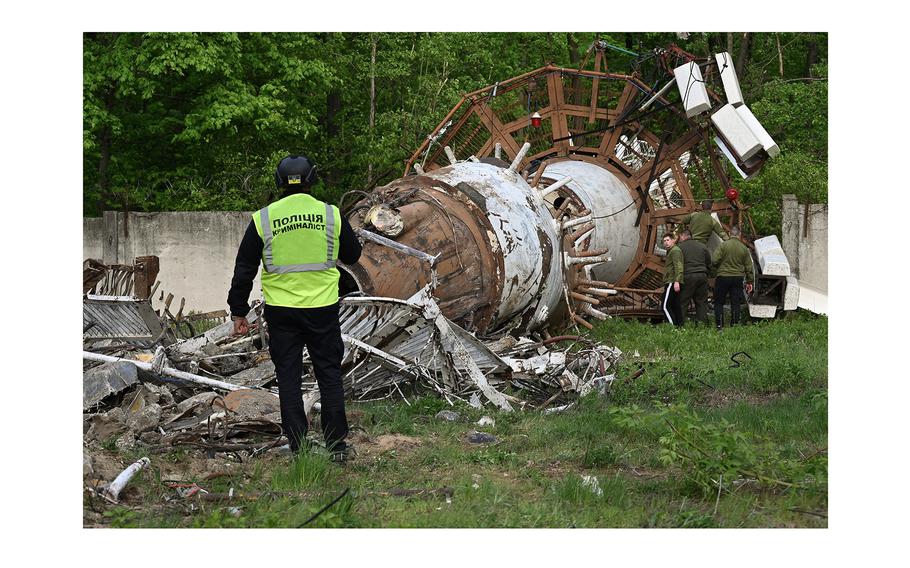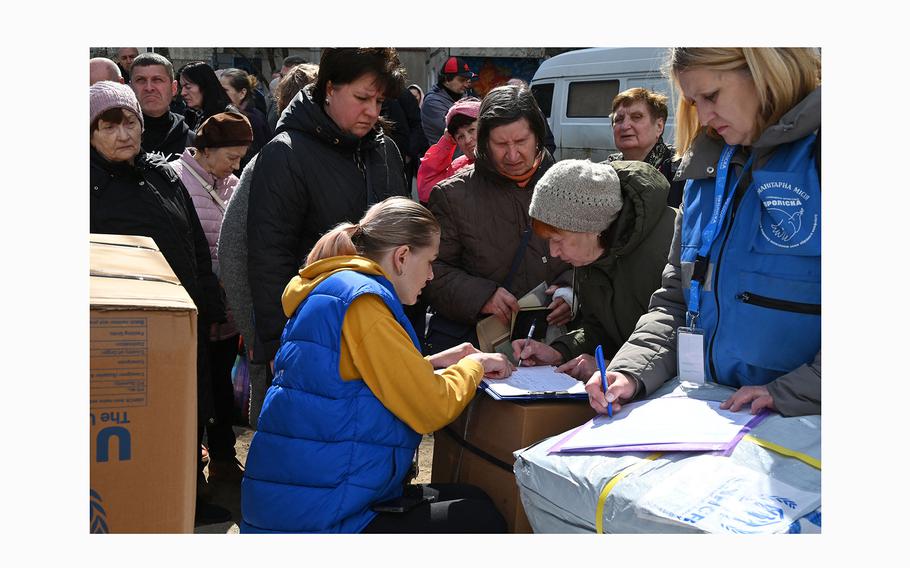
A Ukrainian police investigator examines debris at the Kharkiv Television Tower on the outskirts of Kharkiv on April 22, 2024. (Sergey Bobok/AFP/Getty Images/TNS)
KHARKIV, Ukraine (Tribune News Service) — It made for an unlovely municipal symbol, soaring but hardly graceful: the 800-foot-tall Soviet-era television tower that was for decades a familiar signature in the skyline of Ukraine’s second-largest city, Kharkiv.
Ungainly though the tower may have been, the sight of its red-and-white upper mast plunging spearlike to the ground after a strike Monday by a Russian Kh-59 missile was a stinging affront to many in this city of 1.2 million people, only 25 miles from the Russian frontier.
“It’s as if they want us to know they are right there across the border, that they can try to hurt us at any time of the day or night,” said Andrii Tsarenko, a 23-year-old student who does volunteer relief work at his Kharkiv church. “But we can also show them that we can stand up, no matter what they do.”
With Russian strikes often coming from so close by that they carry only seconds’ warning — air alarms sounding even as missiles are slamming home — that task is more difficult by the day.
Kharkiv, a vibrant academic, cultural and industrial center before the February 2022 Russian invasion, is now Ukraine’s most vulnerable major metropolis. Badly battered at the start of the fighting, when the front lines skirted outlying districts, the city in northeastern Ukraine has in recent weeks come under the worst bombardment since those early days of war.
Using a mix of weaponry, including crude but lethal “glide bombs” that allow the destruction of urban targets from a safe distance, Russia has aimed punishing daily strikes at the city’s residential neighborhoods and crucial infrastructure.
An attack last month knocked out all of Kharkiv’s power-generating capacity, but electricity is flowing from elsewhere in Ukraine — enough, with careful rationing, to keep the city functioning, municipal authorities said.
“They want to terrorize us,” said the city’s mayor, Ihor Terekhov. “We will not allow this to happen.”
The wrecked tower probably couldn’t be repaired until after the war, Terekhov said. But by week’s end, engineers using terrestrial receivers had managed to restore a digital TV signal in Kharkiv.
At a time when Ukraine is widely acknowledged to have lost momentum along a battlefront stretching hundreds of miles, Russia has explicitly signaled its designs on Kharkiv: to overrun the city, or render it uninhabitable, or both.
The arrival of newly approved but long-delayed U.S. military aid may help blunt that push, military analysts said, but the months ahead are likely to be particularly dangerous ones in and near the city.
“The Kremlin is conducting a concerted air and information operation to destroy Kharkiv city, convince Ukrainians to flee, and internally displace millions of Ukrainians ahead of a possible future Russian offensive operation against the city or elsewhere in Ukraine,” the Institute for the Study of War, a Washington-based think tank, said in an assessment this week.
In the face of it all, daily life goes on.

Local residents line up to receive humanitarian aid in Kharkiv, on April 6, 2024, amid the Russian invasion in Ukraine. (Sergey Bobok/AFP/Getty Images/TNS)
Generators roar and sputter on Kharkiv’s sidewalks, powering businesses and cafes during frequent outages. Schoolchildren holding fast to parents’ hands descend into classrooms constructed inside subway stations. First responders rush to the scene of daily strikes, despite deadly loss that has touched their ranks, even their own families.
“Being here is a very specific choice,” said Alyona Udalova, a 34-year-old dance instructor walking her dog in the shrapnel-pocked city center.
“There are so many explosions, but the mind adapts,” said Udalova, who also works at a camp for displaced children. “It’s sad to adapt to this, but you do.”
In a park in the city center, close to a monument dedicated to children killed in the conflict — its base strewn with teddy bears — a pair of pensioners named Raisa and Nataliya shrugged off the idea of hardship.
There was food in the supermarkets and music in the cafes, they said. Their main complaint at the moment was the falling drizzle.
Asked for their full names, they hooted raucously.
“We’re lucky if we can remember our first names!” Raisa hollered.
Thrust and parry, retreat and riposte. The pint-sized fencers, faces obscured by protective gear, were immersed in concentration as their instructor called out encouragement.
The sports center’s fencing hall was wrecked in an airstrike last spring, but a smaller makeshift studio in an undamaged part of the complex was flooded with natural light — which, together with battery-powered scoring sensors, made it possible for daily practice to proceed even without electricity.
“I like it so much, because when I’m fencing, I don’t think about the war,” said 9-year-old Ivan Shmetko, waiting impatiently to suit up and get started.
Fencing has long been beloved in both Russia and Ukraine. In the international arena, Ukrainian fencer Olga Kharlan became a national cause celebre when, at the world championships in Milan last year, she offered a saber tap rather than a traditional handshake to a Russian opponent. She was initially disqualified, but fencing officials later allowed her to return to competition.
Instructor Alyona Kalashnik, 30, said fencing was a good outlet for kids’ anxieties and fears — and a useful reminder that a clever tactician could defeat a larger and more powerful foe.
“She wants to be an Olympic champion one day,” said Nataliya Sokol, 48, watching her 8-year-old daughter, Mia, stylishly dispatch an equally tiny opponent. “It’s good for her to dream this dream.”
The young Kharkiv firefighter fell to his knees, tore off his helmet and buried his face in his hands as he wept. It had happened again: a Russian “double-tap” strike, seemingly meant to deliberately kill rescuers who had rushed to the scene of an attack.
This one had taken his father, also a firefighter.
The first strike, an hour after midnight in a residential area of Kharkiv, damaged a high-rise building and several lower-rise ones. Less than an hour later, as emergency responders were still combing the rubble, disconnecting gas lines and aiding the injured, two more drones hit close by, according to Ukrainian news accounts.
Three rescuers died that night, including 52-year-old Vladyslav Lohinov. His son, working nearby, had immediately feared for his father’s safety when he heard the roar of a fresh explosion. Soon enough, colleagues surrounded and embraced him as they confirmed the older man’s death.
A civilian was killed as well, and a dozen other people injured, local officials said.
“It was a horrible picture,” said Vasylenko Yevhen, a 44-year-old emergency services spokesman who was at the scene. “It’s something unbelievable when you hear that sound” — that of another drone approaching a site crowded with emergency workers.
Russia honed the illegal “double-tap” tactic years ago in Syria, rights groups say, and now it is becoming a pattern across Ukraine. In addition to the Kharkiv strike April 4, similar attacks took place this month near the Black Sea port of Odesa and the southeastern city of Zaporizhzhia.
The strikes are under scrutiny by war-crimes investigators, adding to a backlog of thousands of alleged atrocities. Officials said some emergency response protocols were being revised in order to protect rescuers, but declined to give details for fear of aiding Russia.
“We spend a third of our lives together to fight fires,” said Yevhen. “We treat each other like family. And sometimes, we are dying together. Also like family.”
There was the barista who escaped an occupied city. The cashier who found refuge in Kharkiv after being displaced. Servers with relatives on the front lines, kitchen workers with family members who had been killed or injured.
“Everyone has their war story,” said 29-year-old Kharkiv entrepreneur Dmytro Kabenets, who runs a chain of coffeehouses called Makers, a name he says is meant to evoke not only the creation of caffeinated beverages, but also of community.
In roughly the span of the war, Kabenets’ business has grown to four branches in the city and a fifth in a nearby front-line town called Kupiansk, which was occupied by Russian troops early in the war and whose inhabitants fear it may fall again.
If not for a few boarded-over windows — shattered when an attack in January wrecked the building down the street — this downtown branch would look like a hipster coffeehouse anywhere: young people tapping away at laptops, an Alvin and the Chipmunks video projected on the wall, the espresso machine quietly hissing.
Inscribed on one of the pieces of particleboard covering a tall window is a verse by Maksym Kryvtsov, a well-known Ukrainian poet-soldier who was killed in January at the front.
“My heart stopped beating long ago / It pours out like a river,” one couplet goes.
Kabenets’ daughter was 2 months old when the war began. She is now a toddler, and he and his wife have resolved to stay in the city and keep expanding the cafes into surrounding Kharkiv province.
Many of those who have chosen to remain in Kharkiv, even in these difficult times, tend to voice determined optimism. But others, especially among the city’s large population of displaced people, may be staying put out of a sense of paralysis and despair, according to some who work with them.
Kabenets’ next project — not even a full-fledged shop yet, he said — is in Izyum, occupied earlier in the war like Kupiansk and in likely danger if Russia, as expected, presses an offensive this spring.
Under circumstances like that, he said, it might be nice for people to be able to get a really good cup of coffee.
“For me, it’s not about business and commerce,” Kabenets said “It’s a social project, a project for getting through this war together.”
Onstage, Carmen was passionately scorning her erstwhile lover. Clustered in a dank, darkened corridor offstage, members of the chorus drew themselves up, preparing to burst into song.
Upstairs, the troupe’s plush prewar performance space, one of Europe’s largest opera and ballet theaters, was dark and silent.
Cast members clad in jeans and puffer coats were rehearsing Bizet’s work in a chilly concrete basement, where a raised stage and a makeshift orchestra pit were installed late last year.
Mass gatherings in Kharkiv are still deemed too dangerous, as they have been since the start of the war. But authorities tacitly allow what are literally underground performances, as long as they are not advertised in a manner that would make them a target. One was set in coming days in this basement.
Early in the Russian invasion, the landmark theater — a hulking, slab-like structure likened by some locals to an aircraft carrier — closed after two rockets landed on its roof, but did not explode. The troupe went into exile, basing itself in Lithuania and performing all over Europe to try to keep alive the idea of flourishing Ukrainian culture.
Many are still outside the country, but some remained, or returned for bare-bones productions such as this one.
“It gives us so much joy, you can’t believe it,” said Armen Koloyan, 53, the theater’s opera director. “It demands imagination from us, and from the audience. But we can imagine everything. Even an end to this war.”
©2024 Los Angeles Times.
Visit at latimes.com
istributed by Tribune Content Agency, LLC.